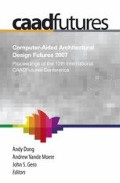A design teaching approach of integrating the notions of design thinking and computing in the first year of architectural design education is introduced and discussed. The approach aims to enhance and bring up-to-date the educational practice of “learning by doing” in the first year foundations curriculum. In the studied example, the analytical phases of thinking in a simple design task are systematically and visually recorded. This documentation is incorporated to the design process as a means for the students to consciously reflect on their design thinking.
Access this chapter
Tax calculation will be finalised at checkout
Purchases are for personal use only
Preview
Unable to display preview. Download preview PDF.
References
Cross, N: 2001, Designerly Ways of Knowing: Design discipline versus design science, Design Studies 17(3):49-55.
Dewey, J: 1944 [1916], Democracy and Education, Free Press, New York.
Eisner, EW: 1972, Educating Artistic Vision, The Macmillan Company, New York.
Garvey, GP: 1997, Retrofitting fine art and design education in the age of computer technology, ACM SIGGRAPH Computer Graphics, 31(3): 29-32.
Gero, JS: 1999, Constructive Memory in Design Thinking, in: G Goldschmidt and W Porter (eds), Design Thinking Research Symposium: Design Representation, Cambridge, MIT, pp I.29-35.
Habraken, NJ and Gross, MD: 1988, Concept design games, Design Studies, 9 (3):150-158.
Ivanka, I and Temy, T: 2005, Using Historical Know-how to Model Design References: A Digital Method for Enhancing Architectural Design Teaching, in: B Martens and A Brown (eds), Computer Aided Architectural Design Futures 2005, Springer, Netherlands, pp. 179-206.
James, W: 1983, Principles of Psychology, Harvard University Press, Cambridge, MA.
Knight, T: 1999, Shape grammars in education and practice: history and prospects, International Journal of Design Computing 2.
Mark, E, Martens, B and Oxman, R: 2001, The Ideal Computer Curriculum, in: H Pentilla (ed) Architectural Information Management, 19th ECAADE Conference Proceedings, Helsinki, Finland, pp. 168-175.
Mark, E, Martens B and Oxman, R: 2003, Preliminary stages of CAAD education, Automation in Construction, Design e-ducation: Connecting the Real and the Virtual, 12(6):661-670.
Naylor, G: 1985, The Bauhaus Reassessed: Sources and Design Theory, The Herbert Press, London.
Özkar, M: 2005, Lesson 1 in Design Computing Does not Have to be with Computers: Basic Design Exercises, exercises in visual computing, in: J Duarte, G Ducla-Soares and AZ Sampaio (eds), eCAADe 23 Digital Design: The Quest for New Paradigms, Technical University of Lisbon, Lisbon, Portugal, pp. 679-686.
Schank, RC: 1995, What We Learn When We Learn by Doing. Technical Report ILS Technical Report No. 60, Institute for Learning Sciences, Northwestern University.
Stiny, G: 1980, Kindergarten grammars: designing with Froebel’s gifts, Environment and Planning B, 7:409-462.
Stiny, G: 2006, Shape: Talking About Seeing and Doing, MIT Press, Cambridge, MA.
Taşlı Pektaş, Ş and Erkip, F: 2006, Attitudes of Design Students Toward Computer Usage in Design, International Journal of Technology and Design Education 16:79-95.
Author information
Authors and Affiliations
Editor information
Editors and Affiliations
Rights and permissions
Copyright information
© 2007 Springer
About this paper
Cite this paper
Özkar, M. (2007). Learning by Doing in the Age of Design Computation. In: Dong, A., Moere, A.V., Gero, J.S. (eds) Computer-Aided Architectural Design Futures (CAADFutures) 2007. Springer, Dordrecht. https://doi.org/10.1007/978-1-4020-6528-6_8
Download citation
DOI: https://doi.org/10.1007/978-1-4020-6528-6_8
Publisher Name: Springer, Dordrecht
Print ISBN: 978-1-4020-6527-9
Online ISBN: 978-1-4020-6528-6
eBook Packages: Architecture and DesignEngineering (R0)

